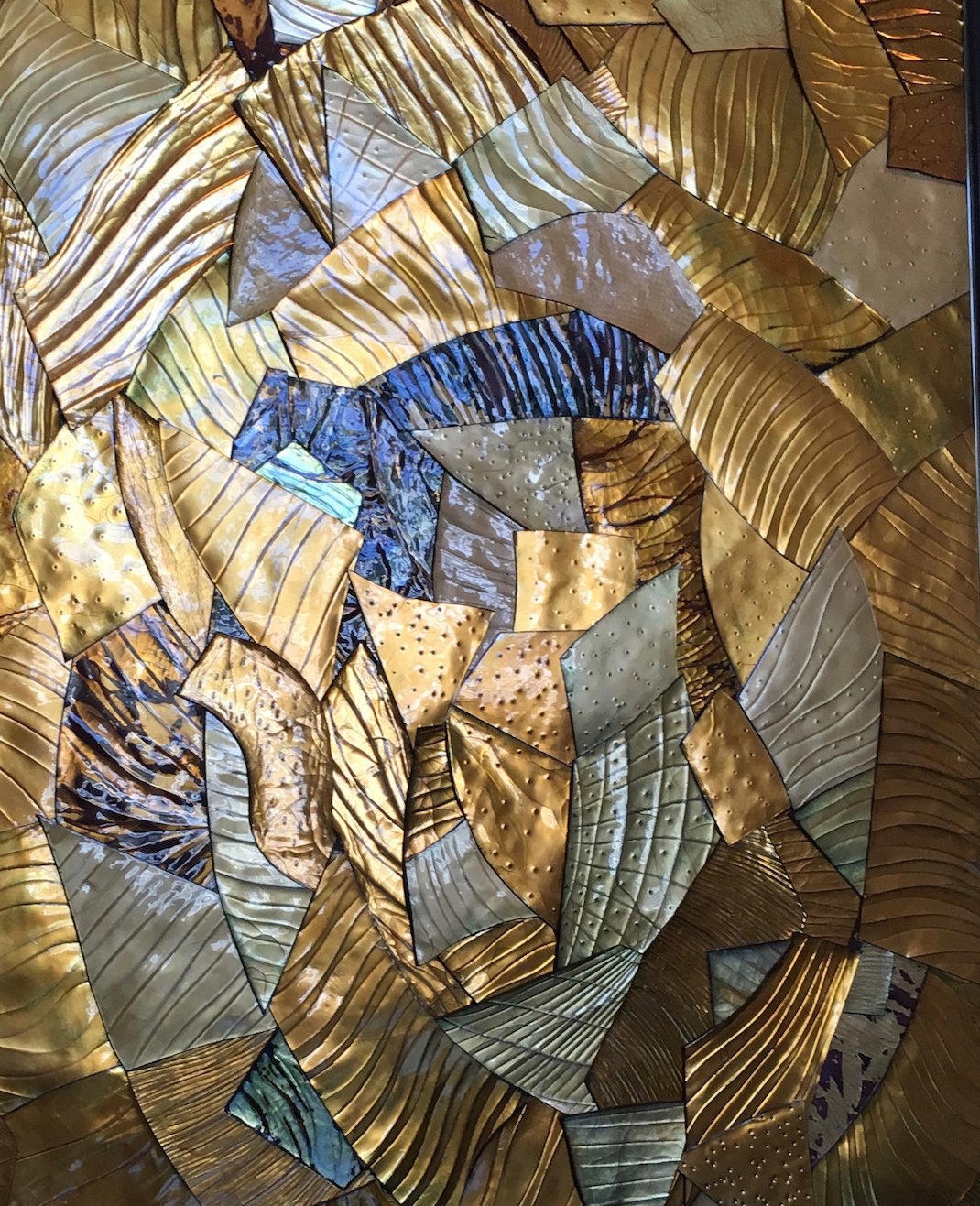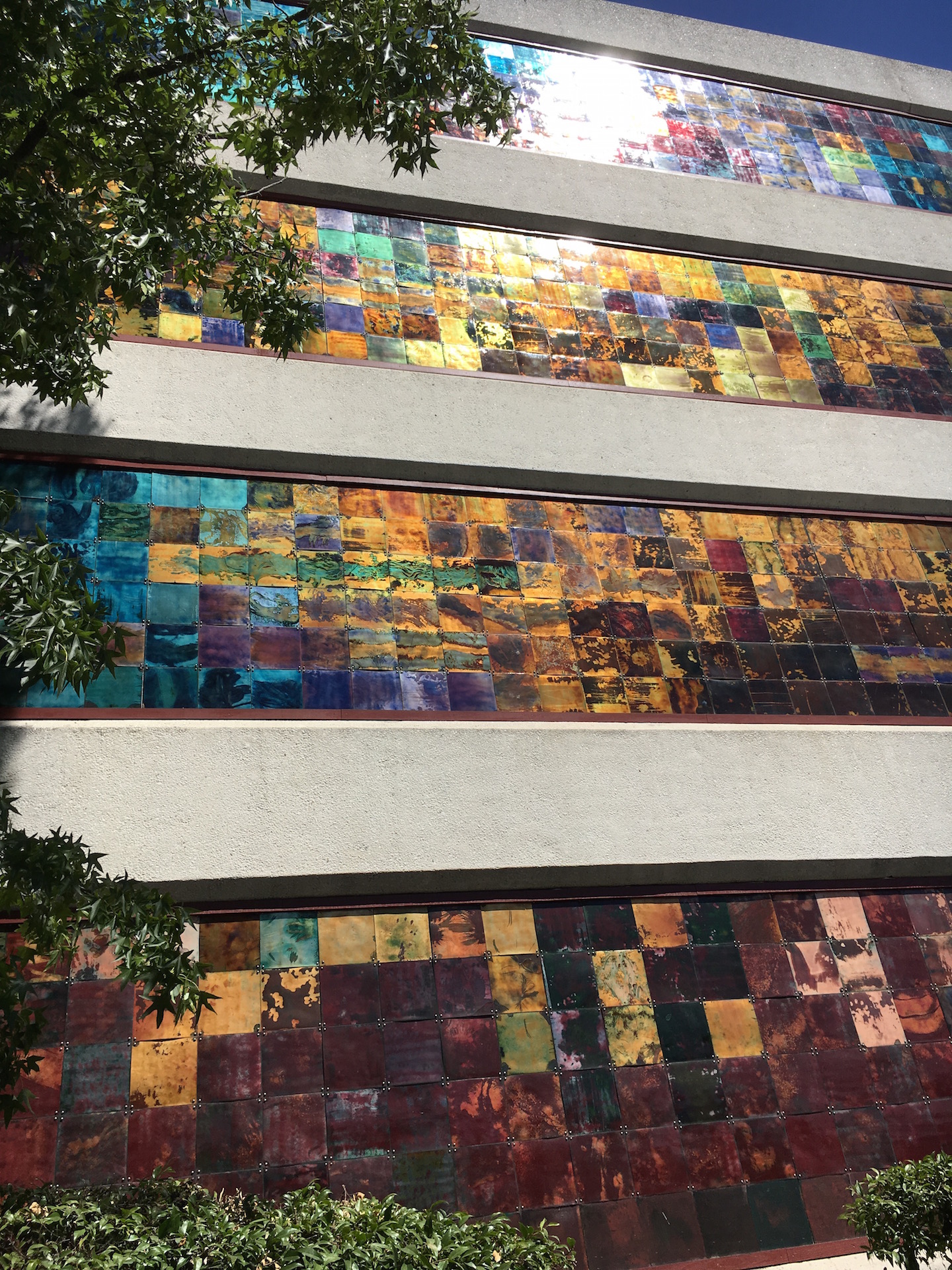by Evelyn Markasky

Detail of Fred Ball piece from the exhibition Little Dreams in Glass and Metal
The Center for Enamel Art is not just a place to take workshops. It also provides opportunities to experience enameling in new and and even life-altering ways. For me, the Center’s bus tour of Fred Ball’s work in Sacramento was this kind of opportunity.
Led by Susan Willoughby, art advisor, long-time leader in the Sacramento art community, and the executor of Ball’s estate, the tour was very well-organized and planned. (Added bonus: We didn’t have to think about driving or parking!) We were taken to some of Ball’s most spectacular public works, and given special access to works in private collections that the public rarely sees. We also got a guided tour of “Little Dreams in Glass and Metal,” the retrospective of enameled work currently on display at the Crocker Museum of Art.
Throughout the tour, Willoughby was a very thoughtful and informative guide, with loads of information about public art and Ball’s many commissions. We were also accompanied by Judy Stone, founder of the CEA, who helped us understand the technical processes that created the work. Having up-close, behind-the-scenes access to Ball’s works, with our own personal expert commentary, was a terrific way to experience the art.

Chase the Clouds Away by Fred Ball, 1977, Sacramento Community Theater
Our first stop was the Sacramento Community Center Theater to see the earliest public Ball piece, Chase the Clouds Away, from 1977. We learned that Ball created this 16’ x 8’ piece with only a 12”x12” kiln. It was really amazing to see an enameled piece that big, and to learn how it was put together.
One of the most interesting things to me was that the enameling was done on thin (36 gauge) copper foil and glued onto the backing pieces. Using glue is something of a no-no in enameling and metalwork, but Ball made it work for him!
Next, we visited the law office of Kronick, Moskovitz, Tiedemann & Girard, one of the first corporations to commission work from Ball. Though it was a Saturday and the office was closed, we were allowed in to see the work up close, where it is installed on the 27th floor. We saw two pieces there, one a more abstract design and the other a larger piece of the mountains.

Detail of a Ball piece commissioned for the law offices of Kronick et al, Sacramento, CA
You could see how his work began to evolve, in the uncharted territory of making enamel pieces this large. It was almost like watching an experiment happen, as he made abstract pieces and began to see how it would all fit together, figuring out, like a jigsaw puzzle, how to put more order into the composition.
We returned to the Crocker for a wonderful lunch, which was also a good opportunity to get to know some of our bus-mates and check out the Crocker gift shop. I loved the old cigarette machine turned into an Art-O-Mat, which dispensed little pieces of art instead of cigarettes.

The Art-O-Mat at the Crocker, which dispenses art instead of cigarettes
After lunch, by special arrangement with the Crocker’s registrar, we were given a private tour of the Fred Ball pieces in the Crocker’s collection. My favorites were the envelopes–at least until I got a closer look at the other pieces! I was very inspired by the collage-like quality of thinly enameled copper pieces. It was so eye-opening to be able to see work like this, work that is so far outside the norm.

Untitled by Fred Ball, 1978, from the exhibition Little Dreams in Glass and Metal
Then Willoughby and Stone took us through the enamel exhibit “Little Dreams in Glass and Metal,” a retrospective of enameling in America, which will be up through September 11th. I know that enameling encompasses more than jewelry, but jewelry has been my focus, and the focus of most enameling workshops and lectures I’ve attended. But many of the works in this exhibit were large, impressive wall pieces, and these were very exciting to see.
Our next stop was the UC Davis Medical Center, to see the large Ball work that was commissioned for their entry lobby. The medical center was so impressed with this work that they committed to building an art collection, which now has more than 2,000 pieces. We were very fortunate here to meet with Ball’s former assistant, Bruce Beck, who spoke with us about working with Ball. We learned how exacting and meticulous Ball was, and the challenges of making a piece this size.

Large wall piece by Fred Ball at UC Davis Medical Center, which owns several of his works
Our last stop was the Macy’s parking garage, where we saw Ball’s largest piece, The Way Home, one of the city’s first public art commissions. Made from four panels, each 6’ x 62’ long, it is believed to be the largest hand-fired enamel piece in existence. We did the math: there were approximately 1116 12”x12” enameled copper squares bolted to the building.

The Way Home, Fred Ball, Macy’s parking garage, Sacramento, CA
A lot of the pieces were cracked and weather-worn, but for me that just made the work more interesting. It seems like we are always trying to make something that will never change, but I prefer to embrace the feel and emotion of pieces that become altered by time. Up close, with the afternoon sun glinting off the enamel, the work was phenomenal–very inspiring.
For me, a lifelong studio jeweler, this tour was transformative. It made me think about enameling, and what I do with it, in a whole new way. Workshops are good; I learn plenty and have lots of fun doing it, but this was really different. It was quite eye-opening to learn about how Ball worked, both the technical details as well as his thought process.
One of the ideas that impressed me most was that of working with your limitations, of being able to expand that into anything. I loved that his pieces had to be 12”x12” because that was the size of his kiln–but that didn’t stop him from making a three-story work of art. It has inspired me to move beyond jewelry into bigger pieces. I don’t know why I have been stuck on jewelry for so long, but this move is really freeing for me. I’m more excited to work than I have been in a long time.

Recent Comments